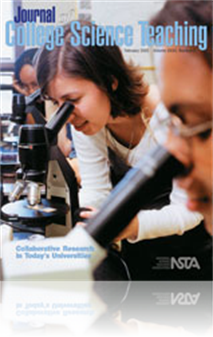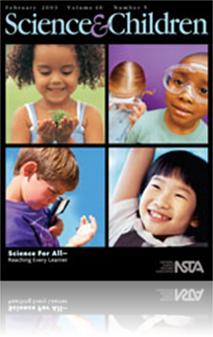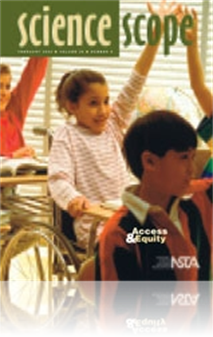All Resources
Journal Article
Modeling Multidisciplinary Science
A common research theme was incorporated into several biology and chemistry courses. Students in participating courses carry out different but complementary experiments and share their results in a poster session. These laboratory experiences are ong...
Journal Article
A first-grade teacher discusses what she gained from her participation in a Science and Children action research project questioning students on their knowledge of animals. The teacher then describes how misconceptions were addressed with a construct...
Journal Article
Editor's Corner: Your Voice Counts
The Science Teacher’s editor shares thoughts on how "your voice counts" in helping influence the future of science education....
Journal Article
The Home Zone: Flying Together
Airplanes, like kites and other flying objects, are of great interest to elementary children. Like the Wright brothers and countless other aviation pioneers, children seem to enjoy the process of designing, making, and modifying airplanes. The follow...
Journal Article
Science and nonscience majors work together in a remote field setting on authentic marine research projects supervised by faculty from multiple disciplines and institutions. In the process, they learn science by doing science, gain research and logis...
Journal Article
Tried and True: Balloons and Newton's Third Law
This constructivist adaptation of the classic balloon-on-a-string exploration leads students to investigate Newton's third law: for every action force there is an equal and opposite reaction force. This hands-on, minds-on activity leads students to...
Journal Article
Careers in Science: An interview with physical vapor deposition and coatings expert Patrick Sullivan
This column shares interviews with professionals using science in the workplace. In this month's feature, find out how Patrick Sullivan became involved in this particular science....
Journal Article
Science Sampler: To heat or not to heat
As part of a lesson on heat transfer, middle school students design their own investigation of conduction, insulation, and convection....
Journal Article
Commentary: Enthusiasm is Contagious
An opinion piece about students learning more when they are excited about the topic, and educators teaching better when they teach about something they are passionate about....
Journal Article
Tech Trek: Science research on the Internet
Young students often get frustrated when trying to find useful information on the Internet for school purposes and end up jumping from one point of interest to another, keeping little focus on the task at hand. To help students achieve success in the...
Journal Article
Did you know that whenever you take a walk in the rain, you have a close encounter with extraterrestrial material? Our atmosphere contains small, microscopic bits of matter called micrometeorites. When scientists study these tiny invaders, they use s...
Journal Article
Concept mapping in the organic chemistry laboratory can supplant cookbook activities with higher cognitive exercises. The common thread of most organic lab experiments is the synthesis, isolation, purification, and characterization of a carbon compou...
Journal Article
Making Science Accessible: Strategies to Meet the Needs of a Diverse Student Population
Despite the sincere interest of many teachers to address the varying educational needs of their students (Scruggs and Mastropieri 1994), the current emphasis on inclusion remains a source of frustration, misunderstanding, and distrust by some teacher...
Journal Article
The importance of environmental influences outside of school has been the focus of numerous studies that support the home’s influence on science learning. Students who come from homes primed with experiences that parallel curriculum are able to imm...
Journal Article
Issues in Science and Technology
In this course, students select a current issue in science and technology and then explore it in a scientific manner. They work in groups and individually to examine the history behind the science and technology that have led to the issue and conside...
Journal Article
A teacher describes how developing a structured, focused, and fun curriculum on rocks and minerals for learning-disabled students transformed her initial reluctance about Earth science into enthusiasm. Students observed, described, and sorted rocks a...
Journal Article
Field Trip Preparation: Increasing student knowledge about matter and energy before a field trip
When student interest is waning toward the end of the school year a class field trip will catch their attention. In this article, activities and discussion about matter and energy prepare students for a more rewarding field trip....







